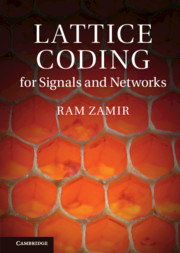 Lattice Coding for Signals and Networks
Lattice Coding for Signals and Networks Book contents
- Frontmatter
- Dedication
- Contents
- Preface
- Acknowledgements
- List of notation
- 1 Introduction
- 2 Lattices
- 3 Figures of merit
- 4 Dithering and estimation
- 5 Entropy-coded quantization
- 6 Infinite constellation for modulation
- 7 Asymptotic goodness
- 8 Nested lattices
- 9 Lattice shaping
- 10 Side-information problems
- 11 Modulo-lattice modulation
- 12 Gaussian networks
- 13 Error exponents
- Appendix
- References
- Index
7 - Asymptotic goodness
Published online by Cambridge University Press: 05 August 2014
- Frontmatter
- Dedication
- Contents
- Preface
- Acknowledgements
- List of notation
- 1 Introduction
- 2 Lattices
- 3 Figures of merit
- 4 Dithering and estimation
- 5 Entropy-coded quantization
- 6 Infinite constellation for modulation
- 7 Asymptotic goodness
- 8 Nested lattices
- 9 Lattice shaping
- 10 Side-information problems
- 11 Modulo-lattice modulation
- 12 Gaussian networks
- 13 Error exponents
- Appendix
- References
- Index
Summary
As the dimension increases, lattices can form richer arrangements of points in space. Richness, though, comes at the cost of a higher complexity. Are high-dimensional lattices better?
The advantage of going to higher dimensions is questionable if we are only interested in sphere packing and covering. The one-dimensional lattice is already perfect for both problems, whereas higher-dimensional lattices are not. To be more specific, the best lattice packing efficiency ρpack gets worse (roughly monotonically) as the dimension increases, and decreases from 1 to the Minkowski bound of onehalf. The best lattice-covering efficiency ρcov exhibits anomalous behavior. First it increases (i.e., deteriorates) but then, by the Rogers bound, it becomes asymptotically perfect again and approaches 1 as the dimension goes to infinity. See more on that later in this chapter.
While mathematicians paid attention to these two hard problems, Shannon and his followers were more interested in the “softer” questions of quantization and modulation. Shannon's theory demonstrates the advantage of high-dimensional source and channel codes. The underlying principle is the law of large numbers. Does this principle apply also to lattice codes?
Lattices indeed improve when it comes to the quantization and the modulation problems.
- Type
- Chapter
- Information
- Lattice Coding for Signals and NetworksA Structured Coding Approach to Quantization, Modulation and Multiuser Information Theory, pp. 134 - 177Publisher: Cambridge University PressPrint publication year: 2014


